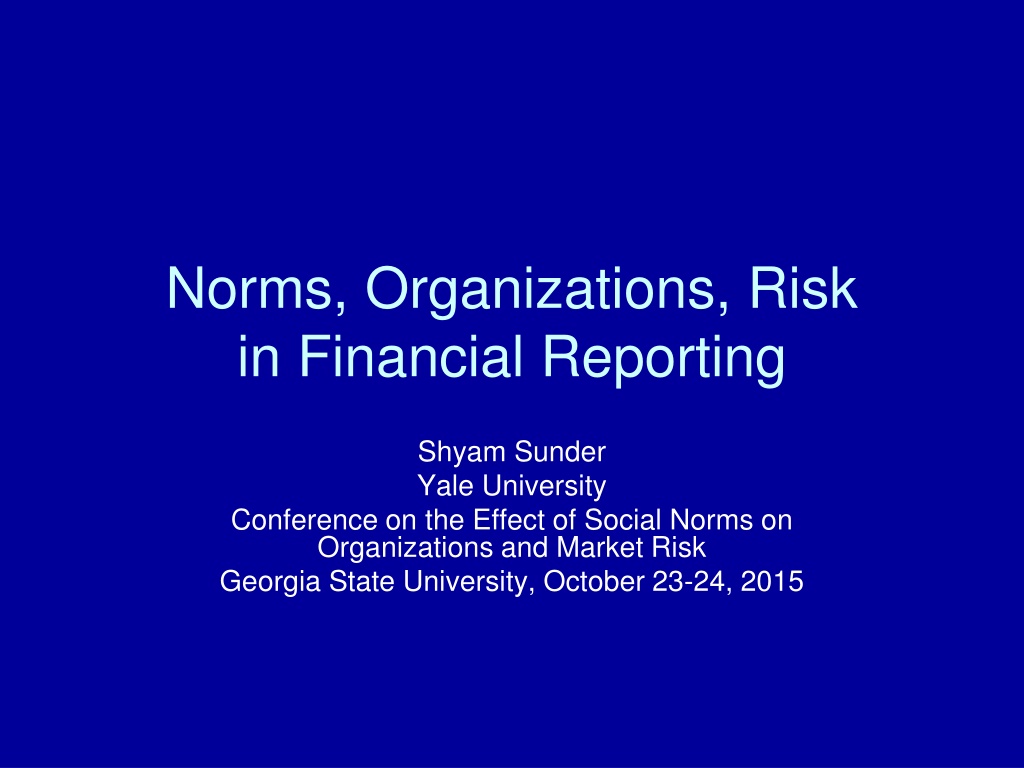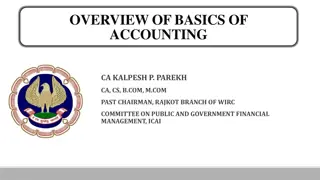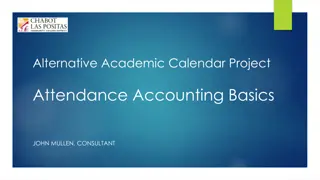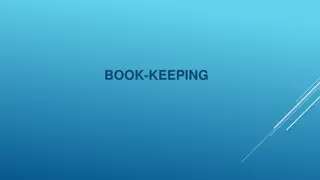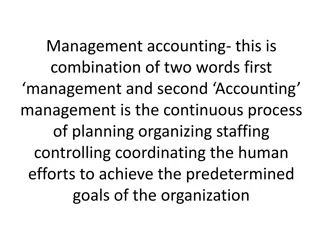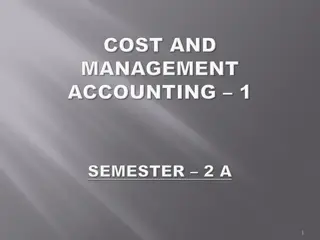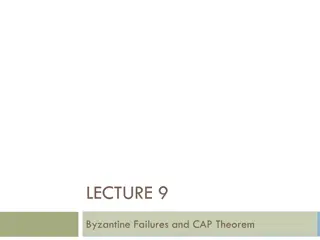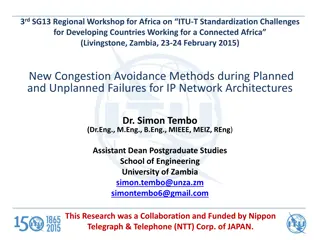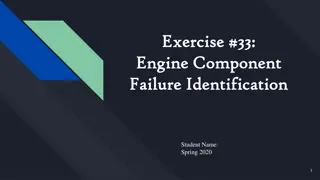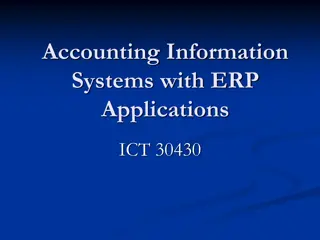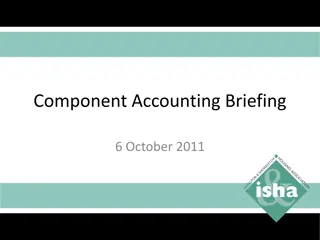Addressing Accounting Failures and Abuses: Perspectives and Solutions
The content explores the issues of accounting failures, abuses, and potential solutions from short, medium, and long-term perspectives. It discusses the role of norms, organizations, and risks in financial reporting, as well as the need for reforms in auditing practices and regulatory oversight to mitigate such problems.
Download Presentation

Please find below an Image/Link to download the presentation.
The content on the website is provided AS IS for your information and personal use only. It may not be sold, licensed, or shared on other websites without obtaining consent from the author. Download presentation by click this link. If you encounter any issues during the download, it is possible that the publisher has removed the file from their server.
E N D
Presentation Transcript
Norms, Organizations, Risk in Financial Reporting Shyam Sunder Yale University Conference on the Effect of Social Norms on Organizations and Market Risk Georgia State University, October 23-24, 2015
An Overview The problem/Question: Can we reduce the number of accounting failures and abuses? Diagnosing the sources of the problem: Short-term, medium-term and longer-term perspectives Focus on the longer-term problem: From the age of norms to the age of written standards The mindset in the background: Design vs. Emergence and evolution Concepts of risk: Hazard vs. dispersion of outcomes Risk in accounting: Choice of risk concepts behind the choice of accounting theories What can we do to address the problem? Some tentative suggestions Each discipline must do its own thinking; accounting can t outsource it 10/9/2024 Sunder: Norms, Organizations, and Risk 2
Accounting Abuses U.S. Accounting abuses and their consequences Response: overhaul of accounting and auditing regimes Additional powers to the Securities and Exchange Commission (SEC) Additional requirements on the certification of internal controls Public Company Accounting Oversight Board (PCAOB) to oversee audits of public firms, write auditing rules, and to monitor audit firms and the industry Effectiveness of these measures an open question Diagnose the problem: short and medium-term issues, and then the longer term issues 10/9/2024 Sunder: Norms, Organizations, and Risk 3
A Short-Term Perspective The immediate causes of failures: beliefs of executives, auditors, lawyers, investment and commercial bankers, and corporate directors that they could default on their duties without bearing the consequences Compounded by the failure of government to discipline the individual failures Cases are winding their way through the courts Will enforcement of the existing laws remedy the problem? Mixed signs so far: Enron s auditor is out of business but its law firm is not Qualified people reluctant to serve as the directors; nominating committees reluctant to choose technically qualified but unknown people for boards More non-employees on audit and compensation committees; but we do not yet know if they would serve the interests of others any better Stock option grant rates slowed down in 2002, yet the rapid rise in the compensation of senior executives continues Stiff resistance to Donaldson s proposals from business and Wall Street 10/9/2024 Sunder: Norms, Organizations, and Risk 4
Medium-Term Perspective Two critical events of the recent decades U.S. government decided to push competition in the audit industry in 1979 (Sunder 2003) Rise in performance-contingent compensation for senior corporate executives Policies driven by the dominant economic theories of the moment Competition was also supported by the U.S. Supreme Court through its decisions (e.g., Bates vs. Bar of the State of Arizona) The general theory (competition promotes economic efficiency) applied to audit industry created a textbook example of a market for lemons Price and quality of audit services declined in the early eighties Audit firms try to find alternative sources of revenue (consulting) Audit services become loss leaders for consulting Fall in prices and the quality of audit services, combined with the increased executive temptation to commit accounting fraud (growth of performance- contingent executive compensation, Erickson et al. 2005) Consequences of this combination were played out over two decades until a sharp drop in the economy and the stock market, following the dotcom bust, brought the house down 10/9/2024 Sunder: Norms, Organizations, and Risk 5
Longer-Term Perspective Over a century, another pattern emerges Since the enactment of the securities laws in the early 1930s, the U.S. has seen a steady shift in financial reporting From business and professional norms towards legislated written standards enforced by threats of explicit punishment for violators This shift altered virtually all aspects of accounting (including education) The recent problems can be seen as a logical consequence of the policy decisions of the past eight decades. 10/9/2024 Sunder: Norms, Organizations, and Risk 6
My Introduction to Norms (after dotcom bust) Sunder, Shyam. Social Norms versus Standards of Accounting. In General Accounting Theory: Towards Balanced Development edited by Mieczys aw Dobija and Susan Martin, 157-177. Cracow, Poland: Cracow University of Economics, 2005. Sunder, Shyam. Minding Our Manners: Accounting as Social Norms. The British Accounting Review 37 (December 2005): 367- 387. 10/9/2024 Sunder: Norms, Organizations, and Risk 7
Accounting by Norms The early twentieth century predominance of norms The charge the American Association of Public Accountants gave to a Special Committee on Accounting Terminology in April 1909 to collate and arrange accounting words and phrases and show in connection with each the varying usages to which they are put. This committee will not attempt to determine the correct or even the preferable usage where more than one is in existence (Zeff 1971, p. 112). In 1918, a memorandum on auditing procedures, prepared by the American Institute of Accountants, and approved by the Federal Trade Commission (FTC), and originally published in the Federal Reserve Bulletin, labeled A Tentative Proposal Submitted by the Federal Reserve Board for the Consideration of Banks, Bankers, and Banking Associations; Merchants, Manufacturers, and Associations of Manufacturers; Auditors, Accountants, and Associations of Accountants. The intent was to coordinate the evolution of norms, and not to impose a standard. 10/9/2024 Sunder: Norms, Organizations, and Risk 8
Facilitating Evolution of Norms In 1918, the American Institute of Accountants appointed a Special Committee on Interest in Relation to Cost to address a lively controversy on imputed interest as part of the cost of production The Committee s recommendation against inclusion of imputed interest in cost of production, approved at the annual meeting of the Institute, does not become accepted as an accounting norm The Institute appoints a special committee on the standardization of accounting procedure to consider all questions of procedure brought before it, and to make recommendations from time to time on vexed questions in the hope that ultimately there may be established something approaching uniformity of procedure throughout the country The charge suggests facilitation to form norms, not legislation of standards. During its eleven-year tenure (1918-1929), the Committee produced six reports, and none was submitted for an official stamp of approval of the membership 10/9/2024 Sunder: Norms, Organizations, and Risk 9
Norms as an Attitude The absence of authoritative standards of accounting did not mean that the world of accounting had less order in the early twentieth century than in the early twenty-first Active mechanisms the accountants used to identify the norms of their profession Journal of Accountancy and the CPA Journal served as forums for active, even feisty debates on accounting and auditing; a function largely abandoned by the accounting journals over the past quarter century when authoritative standards pushed the norms out During 1920-29, the Librarian of the Institute issued 33 special bulletins on topics referred to them, without the authority of the Institute. In 1931, the Institute published a 126-page book Accounting Terminology, a compilation of accounting terms and their definitions as a matter of advice, not authority. (See Kitchen s (1954) Costing Terminology, a cogent argument for resisting the temptation to issue authoritative definitions, especially in accounting) Throughout the 1920s and into 1930s, a committee of the Institute worked in close cooperation with a committee of Robert Morris Associates, an organization of bank loan officers, to respond to inquiries submitted to them. 10/9/2024 Sunder: Norms, Organizations, and Risk 10
Norms Not Enough: An Era Ends Role of fair value accounting in the roaring twenties The stock market crash of 1929 Severe economic depression that followed, precipitated another crash Loss of credibility of norms of accounting, and the formal or informal mechanisms by which these norms evolved and were sustained Too many had lost wealth, livelihoods, even lives Financial reporting transgressions were far too many, people lost trust in the social contract It was time to identify and punish at least constrain the guilty Politicians responded the only way they could and introduced securities laws and regulations. In the following seven decades, accounting and audit failures have been interpreted as evidence that norms do not work; Norms were gradually shifted to the back burner, and legislated accounting standards rose to dominate accounting Have the standards achieved, and can they achieve, their purported goal? 10/9/2024 Sunder: Norms, Organizations, and Risk 11
Federal Securities Regulation In 1933-34, U.S. Congress give SEC the legal authority to regulate financial reporting The first three decades: mostly codifying the existing practices Gradually, these efforts shifted from identification of conventions or social norms to promulgation of legally enforceable standards Increasingly assertive nomenclature of the three private sector organizations to write accounting rules The Committee on Accounting Procedure s Accounting Research Bulletins (1948-59) The Accounting Principles Board s Opinions (1959-73) The FASB s Financial Accounting Standards (1973 to present). (IASB s International Financial Reporting Standards being the latest addition to this trend) By 2000, the social norms have few advocates left, most favor legislated standards (with legal enforcement) model for financial reporting Yet, the evidence that formal standards do any better than social norms of financial reporting remains elusive The case for the efficacy of enforced standards remains to be made In the absence of evidence, should the benefit of doubt go to the government or the market? Thoreau s motto: that government is best which governs least. 10/9/2024 Sunder: Norms, Organizations, and Risk 12
Standards as Progress Accountants shifted their allegiance from norms to authoritative promulgation Profession now views standardization as a measure of progress (our rule book is thicker than yours!) Most research refers to standards with respect, if not approval By the outset of the 1970s, an energetic and ambitious plan was in operation. Zeff on attempts of the English Institute in Lectures on Forging Accounting Principles in Five Countries Baxter analyzed the corrosive effect of authority on accounting profession half-a-century ago Those ideas were largely ignored There has been little research and debate on merits and consequences of standardization 10/9/2024 Sunder: Norms, Organizations, and Risk 13
The Appeal of Standards Written standards: concrete, salient, published, easily disseminated, easy to find, specified formally with some precision, can be analyzed and discussed line and verse They come into existence at a specific time, through a known and understood institutional process that may allow the participation of the constituents; leave written history behind them When the environment changes, a systematic process is available to formulate changes and submit them to a well-specified process for possible promulgation Democratic appeal of a transparent institutional mechanism for setting standards Following accidents and scandals, the rules were not clear is a popular defense Let us make the rules clear to all as a response to calm the political waters Even George O. May, an influential leader of profession and an ardent supporter of norms, responded to William Ripley s Stop, Look and Listen (1926) by a call for clearer definition of authority Formal written standards appeal to our sense of good housekeeping Specified processes for enforcement of violations 10/9/2024 Sunder: Norms, Organizations, and Risk 14
Norms Are Messy Social conventions and norms are rarely well defined, vary in time and space, require an extended socialization process to learn and understand (Coleman [1990]) They carry a penumbra of uncertainty about them Substantial but incomplete overlap among the beliefs of the individual members of a group about its norms Norms evolve in small, almost imperceptible steps, by processes that are not well understood This evolution is decentralized, difficult to predict the future direction While the evolutionary process is not opaque, the lack of definition and our poor understanding of how norms evolve make them less transparent Scandals mock the claims of expertise and efficiency required to legitimize existing institutions During periods of crises, political or bureaucratic decision makers feel pressured to write new standards rather than continue to rely on existing (recently discredited) norms and business practices 10/9/2024 Sunder: Norms, Organizations, and Risk 15
What About Enforcement Formal standards call for formal enforcement Government departments, courts, regulatory agencies, industry associations, and private sector bureaucracies in national and international domains have a stake Formal enforcement of informal social conventions is difficult, no assurance of enforcement Word-of-mouth mechanisms in business relationships provide feedback; damage or enhance reputation (cotton and diamond trades, even e- commerce), but don t always do so Yet, social norms do work, nationally and internationally The human rights movement, even the U.S. yielded recently to evolving international norms on the death penalty for minor and mentally retarded offenders The Texas state anti-sodomy law struck down; the Court cited values shared with a wider civilization European Court of Human Rights, and other nations Standards: apparent advantages of clarity, explicitness, and the power of enforcement; but also disadvantages relative to evolutionary social norms 10/9/2024 Sunder: Norms, Organizations, and Risk 16
Limits of Written Standards Legal scholarship and practice is careful in recognizing the limits of the efficacy of written rules When it is not possible to write a rule that will improve the state of affairs compared to a judgment-based system, the law leaves the judgment in place When a judge asks the jury to determine if the accused is guilty beyond reasonable doubt, lay jurors would want to know how much doubt is reasonable: ten percent, two percent, or one percent? Law does not attempt to codify answers to such questions People who write and practice law understand all too well the consequences of clarifying such questions would be even less desirable than the consequences of leaving the answers to the best judgment, even of lay people The SEC and the U.S. Congress refuse to clarify the definition of insider trading beyond trading on non-public information Again, the consequences of clarification are even less desirable than the consequences of leaving such matters to judgment. 10/9/2024 Sunder: Norms, Organizations, and Risk 17
Drawing Road Maps for Evasion Unfortunately, accountants willing to pursue endless clarification of accounting rules to the point of defining the percentages that justify Materiality Lease capitalization Consolidation Non-consolidation of special purpose entities, etc. With such written standards it is child s play for the Wall Street bankers, accountants, and lawyers to design transactions to frustrate the intent of the standards Contrary to their intent, standard setters end up drawing road maps for evasion The Wall Street (and perhaps the City) loves it; but fair reporting gets lost Setting up accounting institutions such as the FASB and the IASB, whose sole function is to issue new accounting rules, has contributed to the tendency to write standards which are generally accepted only by fiat of authority Wisdom from law, abolish the rule making monopolies in various jurisdictions, and introduce competition among rule makers with each financial reporting jurisdiction in order to address this problem (Dye and Sunder 2001, Sunder 2002). 10/9/2024 Sunder: Norms, Organizations, and Risk 18
Intelligent Design Complex social or biological systems can be DESIGNED by conscious intelligent entities They have the ability and wisdom to define the ends, and design systems to attain these ends efficiently They are, or should be, invested with the power to enforce their design on others For accounting, where does such an entity reside? 10/9/2024 Sunder: Norms, Organizations, and Risk 19
Emergence Darwin: Complex, in fact all, biological systems evolve over time through mutation and natural selection in their environment Evolution has no goals or direction of advancement except time Evolution does not guarantee efficiency The resultant designs incorporate enormous amount of information Design, without designer Spencer: social evolution 10/9/2024 Sunder: Norms, Organizations, and Risk 20
The Pretense of Knowledge F. A. Hayek: Social systems emerge through simple interactions among individuals Preferences and information is inherently dispersed among individuals, and no central authority can have access to this information to achieve efficient central planning, even if it were feasible to do so computationally Markets are able to aggregate the preferences and information in possession of millions of individuals Organization emerges through interactions among micro-units To act on the belief that we possess the knowledge and the power which enable us to shape the processes of society entirely to our liking, knowledge which in fact we do not possess, is likely to make us do much harm. 10/9/2024 Sunder: Norms, Organizations, and Risk 21
Journey from Norms to Standards U.S. project to standardize accounting since the 1930s Seven decades of standards as the solution: today they dominate accounting thought, practice, regulation, instruction, and research Generally accepted accounting principles no longer a mere description in its plain English meaning of a generally accepted societal norm Capitalized into a proper name Generally Accepted Accounting Principles GAAP as rules issued by authority with power to punish nonconformance How and why did written standards replaced norms and responsibility? What are the consequences of this transformation? Alternative courses for accounting and corporate governance? Reliance on standards rooted in a misunderstanding of legal reasoning Chasing objectivity without personal responsibility Law, family, neighborhood, drug and alcohol abuse, workplace, dress, table manners, and sports all balance social norms and written standards Re-establishing a balance in accounting and corporate governance may help Thinking in and out of the accounting box Are written standards a solution to our problems, or a problem themselves? 10/9/2024 Sunder: Norms, Organizations, and Risk 22
Risk in Accounting Concepts, measurement, human perception, and attitudes towards risk Two primary concepts of risk Possibility of harm or loss Dispersion of outcomes They overlap partially Depending on the context to distinguish between the two works some times, but can also create confusion Insurance literature and practice Pure risk Speculative risk 10/9/2024 Sunder: Norms, Organizations, and Risk 23
Relationship between Expected Loss vs. Standard Deviation (Friedman, Isaac, James, and Sunder, Risky Curves, Routledge 2014) 121 Lotteries with uniform distribution with different parameters 121 Lotteries on (-0.5, 0.5) with beta distribution with different parameters 0.6 6 0.5 5 0.4 4 Exp(loss) Exp(loss) 0.3 3 0.2 2 1 0.1 5 0 0.3 0 0 1 2 3 4 6 7 0.35 0.4 0.45 0 0.05 0.1 0.15 0.2 0.25 Stdev Stdev Sunder: Risk in Insurance 24
Risk as Possibility of Harm or Loss Possibility of undesirable outcome(s); used in Engineering (component failure) Medicine (heart disease) Public health (epidemic) Sports (injury) Environment (drinking water contamination) Regulation (fraud) Credit (default, liquidity) Insurance (accident, fire, death, etc.) Probability of a negative outcome, the magnitude/consequences of potential negative outcome, or the negative outcome itself Sunder: Risk in Insurance 25
Risk as Dispersion of Outcomes (Financial Economics) Dispersion of outcomes, as in Markowitz portfolio theory (variance) Capital asset pricing model (beta/covariance) June 6, 2012 search of SSRN.com database of 345,529 research papers The word risk appears in the titles of 11,144 (3.3%) of all papers Of the ten most frequently downloaded of these finance papers, six use the hazard meaning of risk, three use the dispersion meaning, and one uses both. Sunder: Risk in Insurance 26
Risk in Accounting (Sunder, forthcoming in Abacus, 2015) Major conflict in accounting theory between historical cost vs. market values Historical cost with LCM (Ijiri) makes sense if hazard/loss is the relevant concept of risk to be avoided Market values (Chambers, Sterling) makes sense if dispersion of outcomes is the concept of risk relevant to accounting Most accounting theory debates methods of dealing with risk without recognizing this fundamental difference between the two concepts of risk Which concept is relevant? An empirical issue For review of empirical evidence: see Friedman et al. 2014. 10/9/2024 Sunder: Norms, Organizations, and Risk 27
Accounting Reforms The pendulum seems to have swung far from norms in the direction of written standards Reconsider a stronger role of social norms and personal and professional responsibility in accounting and business Rethink performance-contingent executive compensation Transfer control of accounting system Reconsider virtues of promoting competition among auditors (a market for lemons ) Better use of social norms: fair representation as a moral compass of accounting As guilty beyond reasonable doubt in criminal law Neither can be captured in written standards Creation of accounting courts to judge fairly represent (Spacek) Assist evolution of accounting norms through competition among multiple accounting rule makers (no collusion, no convergence, not intelligent design) Remove rule-making monopolies in U.S., Europe (and elsewhere) Look carefully before adopting methods of financial economics in accounting Remove mandatory audit One accounting for tax and financial reporting Dye-Glover-Sunder impossibility theorem 10/9/2024 Sunder: Norms, Organizations, and Risk 28
However, Care to Balance Norms are no panacea Slavery Caste and other social hierarchies Corruption Pittsburgh left turn Women s rights, education, jobs, pay Child labor Accounting academia and fair value (Milgram) Nor is higher trust a panacea Refereeing Quality control in a factory Competition Adam Smith and Hayek, information aggregation Corner solutions are unlikely to be optimal; need a balance How do we develop a balance? Process or specific outcomes? 10/9/2024 Sunder: Norms, Organizations, 29 and Risk
Thank You Please send comments to Shyam.sunder@yale.edu Relevant papers available at: www.som.yale.edu/faculty/sunder/research 10/9/2024 Sunder: Norms, Organizations, and Risk 30
